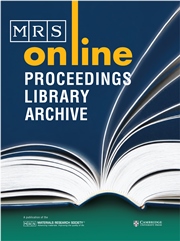Article contents
Deformation Microstructure Under Nanoindentations in Cu Using 3D X-Ray Structural Microscopy
Published online by Cambridge University Press: 11 February 2011
Abstract
We have used a recently developed x-ray structural microscopy technique to make nondestructive, submicron-resolution measurements of the deformation microstructure below a 100mN maximum load Berkovich nanoindent in single crystal Cu. Direct observations of plastic deformation under the indent were obtained using a ∼0.5 μm polychromatic microbeam and diffracted beam depth profiling to make micron-resolution spatially-resolved x-ray Laue diffraction measurements. The local lattice rotations underneath the nanoindent were found to be heterogeneous in nature as revealed by geometrically necessary dislocation (GND) densities determined for positions along lines beneath a flat indent face and under the sharp Berkovich indent blade edges. Measurements of the local rotation-axes and misorientation-angles along these lines are discussed in terms of crystallographic slip systems.
Information
- Type
- Research Article
- Information
- Copyright
- Copyright © Materials Research Society 2003
References
REFERENCES
- 4
- Cited by

